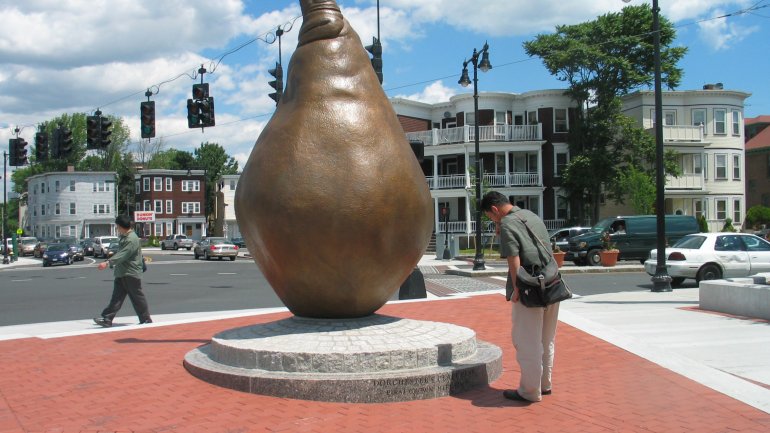Laura Baring-Gould's Weighty Wonders
“Artists and makers, since the beginning of time, have made work that’s public and have also made work that’s intimate and domestic,” says Boston-based sculptor Laura Baring-Gould. “I feel incredibly fortunate to have worked in both realms and to continue to make work in both realms.”
Baring-Gould disregards boundaries and avoids pigeonholing. She creates palm-sized sculptures that become fixtures in people’s homes, but she also builds massive pieces that sit in prominent civic locations. Since the early 1990s, some of her work has existed in galleries, some in living rooms.
What ties all of Baring-Gould’s output together is a commitment to personal connection. She explains, “The function of art, whether you’re working in craft or in public art, is to engage wonder and curiosity.” This engagement may take the form of a small bronze pear that can sit on a mantle – Baring-Gould proudly notes that such pieces have survived house fires – or the much larger bronze pear that adorns an intersection in Dorchester, Massachusetts. The latter installment is surrounded by ten smaller sculptures, ranging from ears of corn to a baseball mitt, that reflect the lives of community members throughout history.
Whether for a public square or a private residence, every piece Baring-Gould makes receives extraordinary attention and care. “The work that I make is tested in my hand,” she says, “and it’s experienced by other people in the hand, and that becomes something that tells them about their body or their awareness.”
Baring-Gould’s smaller sculptures for the home often surprise with their heft; “So heavy!” wrote one reviewer on the artist's website. That sense of weight and permanence is an objective of hers. It enhances the distinction between her careful, laborious craft work and the disposable, temporary nature of mass-produced pieces.
Baring-Gould is also particularly attentive to history, and much of her work examines the ways past events resonate in today’s communities. 2001’s Conspire – a collaboration with fellow Boston artist Michael Dowling – dealt with the city’s varied and complicated legacy, with sculptures placed at four historic meetinghouses and a culminating installation of a full-scale copper meetinghouse on a barge in the Navy Yard.
In this work too, Baring-Gould considers how she might provide something thoughtful and lasting. “How could artists be part of sharing the history of a place differently than a historical brochure might do?” she asks. The question is rhetorical – or, at least, it doesn’t need a verbal response; everything Baring-Gould makes contains the answer. Her pieces are designed not to be glanced at but to be lived among as they reveal their truths over time.


